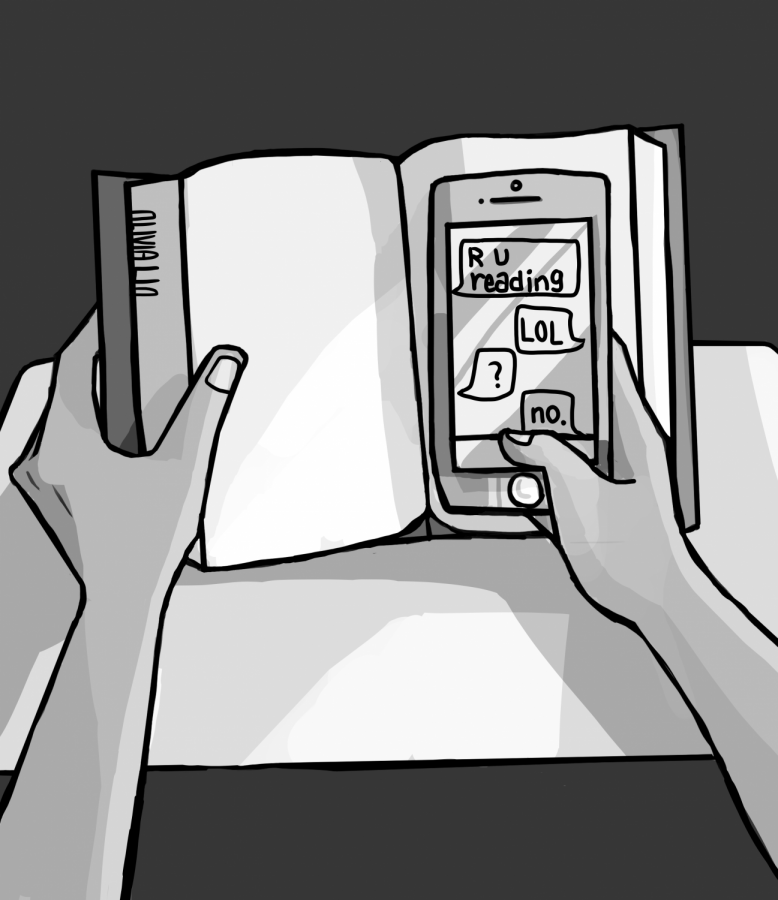Leisure Reading : A Thing of the Past?
The Hate U Give, Harry Potter and the Deathly Hallows, Ender’s Game– Some of the greatest young adult novels have been written within the past half-century, and yet, within those 50 years, a contradictory trend has formed among young adults. The American Time Use Survey has shown that while the average reading time for Americans between 2004 and 2017 fell, the average amount of time watching TV rose. In 2017, the average American spent more than 2 hours 45 minutes per day watching TV, every day of the year, or nearly 10 times the amount of time they devoted to reading for pleasure.
Polls among the student body have noted that students who read read voraciously, while those who do not have not willingly picked up a book since childhood days. There is barely any middle ground between these two extremes. Why do some people maintain that childhood love for reading while it vanishes for others?
The easiest answer is that people are just not entertained by books anymore. As children, our interests were simple and easily satisfied by paperback novels like the Magic Tree House series or City of Ember. As we grew, the medium of literature slowly fell out of favor with tech-savvy audiences who preferred TV or the Internet as entertainment.
The obvious reasons for the decline are also the lack of available time and the relatively recent developments of technology – most notably Instagram, YouTube, and Netflix. As students age, their workload increases and intensifies, and extracurriculars often take up the time that could be allotted to reading. Simply put, reading is no longer a priority when faced with education. Only those who thoroughly enjoy reading are committed to making time to pursue it. In addition, the mindless tasks of scrolling through Twitter, watching YouTube game playthroughs, and binging “Grey’s Anatomy” for hours on end are perfect for stressed, weary students who don’t want to have to put in effort for entertainment. “When I’m bored, I’d rather play video games or go on YouTube” says senior Dylan Gasiorowski.
However, the issue is more complex than it seems. An often overlooked viewpoint is that reading requires too much preparation. The research and other efforts required to obtain a satisfactory book are far greater than what most people are willing to put in. Even if someone decided to give reading a try, chances are, they’d choose a novel without prior research, leaving them likely to succumb to boredom or dissatisfaction. As junior Chryslyn D’Souza stated, “Once something goes wrong, you’re less likely to want to try it again.” This negative experience would deter them from attempting any such endeavors in the future.
Furthermore, the act of reading itself is brainpower intensive. It is extremely difficult to read absentmindedly. One has to focus and think about what is going on to enjoy it, which is generally considered unfortunate by the teenager who has neither the time nor energy to think during their limited amounts of free time. Research done at Harvard University shows that many different parts of the brain are responsible for the ability to read. The temporal lobe is responsible for phonological awareness and decoding/discriminating sounds. The frontal lobe handles speech production, reading fluency, grammatical usage, and comprehension, making it possible to understand simple and complex grammar in our native language. The angular and supramarginal gyrus serve as a “reading integrator” (a conductor of sorts), linking the different parts of the brain together to execute the action of reading. These areas of the brain connect the letters c, a, and t to the word cat that we can then read aloud. On the other hand, watching TV may idle these parts of the brain; instead the visual cortex, primary auditory cortex, and temporal lobe are stimulated to interpret visual information, comprehend auditory information, and recognize objects and visual stimuli respectively.
It is also difficult to break habits and begin to read. Humans are inherently opposed to change, and someone who is new to the realm of literature may be reluctant to alter their routine and try something different.
All of this brings us to the question: why do we read?
The vast majority of people read for pure enjoyment – to escape our problems for just long enough to realize that they actually aren’t as important as they seem, to experience new things and visit new countries and time periods without ever leaving the comfort of our homes. Especially as children, we read for pleasure. As we grow older, we might discover new purposes for reading – perhaps to learn a new concept, strengthen our understanding of a certain subject, or improve our vocabulary. Overall, reading helps us connect with other people, similar to TV shows and movies.
A recent trend has been gaining momentum among adults – book clubs. After much of the stress that comes with high level education subsides, adults “rediscover” reading and all it has to offer. Instead of being a nuisance, having set deadlines and peers to discuss the book with helps adult readers stay focused and motivated. Without schoolwork, adults have more time to focus on leisurely activities, which includes reading for many. At Morris Hills, a 75% of teachers interviewed said they enjoyed reading in their free time and picked up a book at least once a month.
Perhaps it’s time for teenagers to reclaim our long-lost love of reading. The next time you’re bored, try picking up a book before turning to social media or video games. If printed books don’t quite work for you, try audio books or ebooks. Start small – maybe just a few pages a day – to build up a comfortable routine. It may be easier to start off buying books; readers have the ability to take as long as they want to read, in comparison to borrowing from libraries. In schools, curriculum permitting, teachers could offer more independent reading assignments to give students the opportunity to choose novels based on their interests. To ensure you choose a good book to try, ask friends with similar interests, or teachers for recommendations. The key to increasing time spent reading is to make it less effort for students, who will then be less inclined to balk at the very thought. Recent trends in young adult novels feature those in sci-fi and dystopian genres. Looking for a good read? Pick up Marie Lu’s futuristic novel Warcross, James Dashner’s Maze Runner, or Kiersten White’s historical And I Darken for a quality reading experience.


